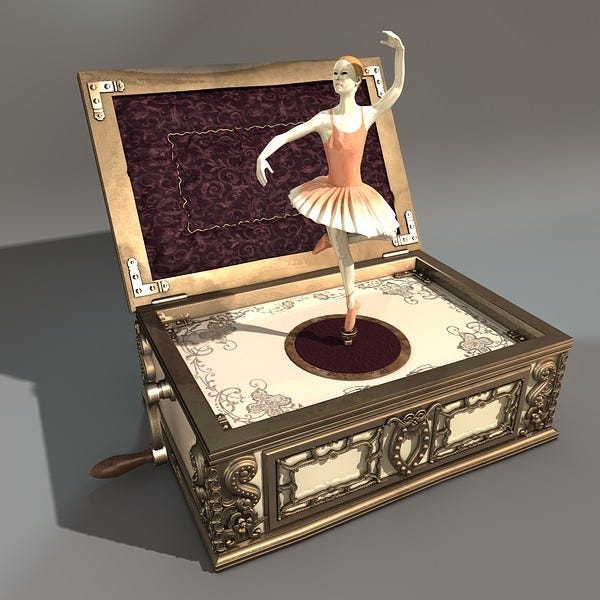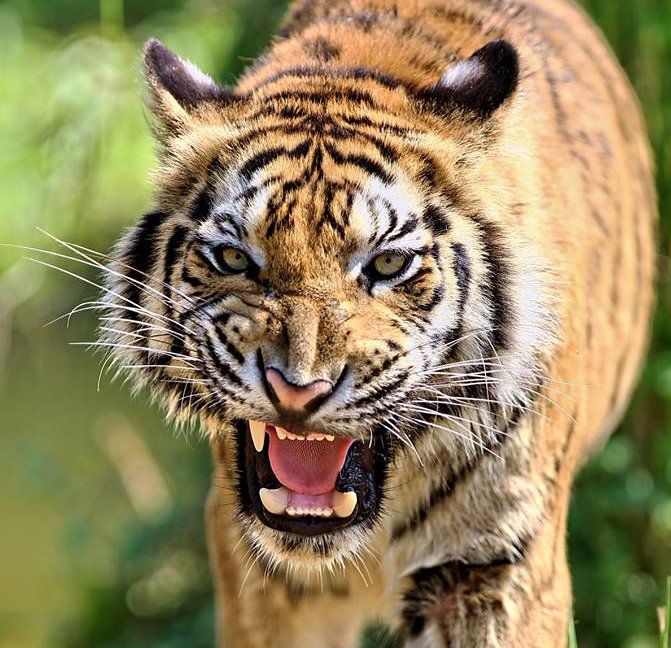Gender and Nature in Beauty and the Beast
This week, our class' readings focused on the different variations of the "the tale as old and time" - Beauty and the Beast. One particularly interesting version of the story that we read was "The Tiger's Bride," a short story by Angela Carter which is based heavily on the traditional Beauty and the Beast narrative, but with a few key differences. Not only is the story written in lush, descriptive prose (making it a fairy tale as appose to a folk tale according to our earlier definition), but it also succeeds in subverting at least two of the central themes of the more well-known version of the story written by Jeanne-Marie de Beaumont.
 The first of these themes is gender. In de Beaumont's older telling of the story, this theme is a bit more subliminal, but in Carter's retelling, it takes center stage. One way that this is done is by focusing more on the lack of agency that Beauty seems to have in whether or not she is handed over to the Beast. Instead of glossing over the way that Beauty is essentially treated by the Beast as an object or piece of property in a transaction between the himself and her father (as de Beaumont seems to) Carter leans into this aspect of the story by having Beauty's father loose her to the Beast in a game of cards. The fact that her father is willing to bet his daughter's life in this way implies pretty heavily that he considers her to be a piece property, not a person. This subversion of de Beaumont's version of the story becomes even more clear when it is noted that Beauty and the Beast may have originally been a story meant to help prepare young girls for the anxiety of arranged marriages.
The first of these themes is gender. In de Beaumont's older telling of the story, this theme is a bit more subliminal, but in Carter's retelling, it takes center stage. One way that this is done is by focusing more on the lack of agency that Beauty seems to have in whether or not she is handed over to the Beast. Instead of glossing over the way that Beauty is essentially treated by the Beast as an object or piece of property in a transaction between the himself and her father (as de Beaumont seems to) Carter leans into this aspect of the story by having Beauty's father loose her to the Beast in a game of cards. The fact that her father is willing to bet his daughter's life in this way implies pretty heavily that he considers her to be a piece property, not a person. This subversion of de Beaumont's version of the story becomes even more clear when it is noted that Beauty and the Beast may have originally been a story meant to help prepare young girls for the anxiety of arranged marriages.
This notion of the objectification of Beauty (and women in general) is further developed in "The Tiger's Bride" by the image of the mechanical maid that the Beast assigns to wait on Beauty. The maid looks almost exactly like Beauty, but also appears distantly artificial. This seems to symbolize the unrealistic expectations that are heaped on Carter's Beauty in her everyday life, as well as on her predecessor in de Beaumont's version of the story through the opposition between the ugly, unintelligent Beast who must be loved for his character and the women who are either perfect in every way (Beauty) or completely awful (her sisters). At the end of the story, Beauty decides to send the mechanical maid back in her place to her father's house, with the implication being that he will like the perfect machine-possession he expects and desires better than the imperfect person he had bet to the beast.
 As for Beauty herself, she decides to stay with the Beast and, in a much clearer subversion of the original story, allows him to turn her into a Beast (a tiger in this case), instead of her turning him human. This ending not only subverts the theme of celebrating "the civilizing power of feminine virtue and its triumph over crude animal instincts" (Tatar 37) which is often found in earlier, European versions of the story, but also seems to questions whether "civilization" is actually something to be praised. It is, after all, the culture of civilization in which Beauty is oppressed and treated like a piece of property, even by her father, who is supposed to love her. Seemingly realizing all of this by the end of the story, Carter's Beauty is freed by the Beast from the cultural restrictions of civilization and returns to a state of Nature in which she can exercise true agency.
As for Beauty herself, she decides to stay with the Beast and, in a much clearer subversion of the original story, allows him to turn her into a Beast (a tiger in this case), instead of her turning him human. This ending not only subverts the theme of celebrating "the civilizing power of feminine virtue and its triumph over crude animal instincts" (Tatar 37) which is often found in earlier, European versions of the story, but also seems to questions whether "civilization" is actually something to be praised. It is, after all, the culture of civilization in which Beauty is oppressed and treated like a piece of property, even by her father, who is supposed to love her. Seemingly realizing all of this by the end of the story, Carter's Beauty is freed by the Beast from the cultural restrictions of civilization and returns to a state of Nature in which she can exercise true agency.
Works Cited:
Tatar, Maria. “Introduction: Beauty and the Beast.” The Classic Fairy Tales: Texts, Criticism, W.W. Norton Et Company, 2017, pp. 31–39.
Picture Credits:
https://www.walmart.com/ip/Anastasia-Alexandra-Nicholas-Hinged-Trinket-Box/46339216
https://www.balisafarimarinepark.com/animals/tigers/
 The first of these themes is gender. In de Beaumont's older telling of the story, this theme is a bit more subliminal, but in Carter's retelling, it takes center stage. One way that this is done is by focusing more on the lack of agency that Beauty seems to have in whether or not she is handed over to the Beast. Instead of glossing over the way that Beauty is essentially treated by the Beast as an object or piece of property in a transaction between the himself and her father (as de Beaumont seems to) Carter leans into this aspect of the story by having Beauty's father loose her to the Beast in a game of cards. The fact that her father is willing to bet his daughter's life in this way implies pretty heavily that he considers her to be a piece property, not a person. This subversion of de Beaumont's version of the story becomes even more clear when it is noted that Beauty and the Beast may have originally been a story meant to help prepare young girls for the anxiety of arranged marriages.
The first of these themes is gender. In de Beaumont's older telling of the story, this theme is a bit more subliminal, but in Carter's retelling, it takes center stage. One way that this is done is by focusing more on the lack of agency that Beauty seems to have in whether or not she is handed over to the Beast. Instead of glossing over the way that Beauty is essentially treated by the Beast as an object or piece of property in a transaction between the himself and her father (as de Beaumont seems to) Carter leans into this aspect of the story by having Beauty's father loose her to the Beast in a game of cards. The fact that her father is willing to bet his daughter's life in this way implies pretty heavily that he considers her to be a piece property, not a person. This subversion of de Beaumont's version of the story becomes even more clear when it is noted that Beauty and the Beast may have originally been a story meant to help prepare young girls for the anxiety of arranged marriages.This notion of the objectification of Beauty (and women in general) is further developed in "The Tiger's Bride" by the image of the mechanical maid that the Beast assigns to wait on Beauty. The maid looks almost exactly like Beauty, but also appears distantly artificial. This seems to symbolize the unrealistic expectations that are heaped on Carter's Beauty in her everyday life, as well as on her predecessor in de Beaumont's version of the story through the opposition between the ugly, unintelligent Beast who must be loved for his character and the women who are either perfect in every way (Beauty) or completely awful (her sisters). At the end of the story, Beauty decides to send the mechanical maid back in her place to her father's house, with the implication being that he will like the perfect machine-possession he expects and desires better than the imperfect person he had bet to the beast.
 As for Beauty herself, she decides to stay with the Beast and, in a much clearer subversion of the original story, allows him to turn her into a Beast (a tiger in this case), instead of her turning him human. This ending not only subverts the theme of celebrating "the civilizing power of feminine virtue and its triumph over crude animal instincts" (Tatar 37) which is often found in earlier, European versions of the story, but also seems to questions whether "civilization" is actually something to be praised. It is, after all, the culture of civilization in which Beauty is oppressed and treated like a piece of property, even by her father, who is supposed to love her. Seemingly realizing all of this by the end of the story, Carter's Beauty is freed by the Beast from the cultural restrictions of civilization and returns to a state of Nature in which she can exercise true agency.
As for Beauty herself, she decides to stay with the Beast and, in a much clearer subversion of the original story, allows him to turn her into a Beast (a tiger in this case), instead of her turning him human. This ending not only subverts the theme of celebrating "the civilizing power of feminine virtue and its triumph over crude animal instincts" (Tatar 37) which is often found in earlier, European versions of the story, but also seems to questions whether "civilization" is actually something to be praised. It is, after all, the culture of civilization in which Beauty is oppressed and treated like a piece of property, even by her father, who is supposed to love her. Seemingly realizing all of this by the end of the story, Carter's Beauty is freed by the Beast from the cultural restrictions of civilization and returns to a state of Nature in which she can exercise true agency.Works Cited:
Tatar, Maria. “Introduction: Beauty and the Beast.” The Classic Fairy Tales: Texts, Criticism, W.W. Norton Et Company, 2017, pp. 31–39.
Picture Credits:
https://www.walmart.com/ip/Anastasia-Alexandra-Nicholas-Hinged-Trinket-Box/46339216
https://www.balisafarimarinepark.com/animals/tigers/
Comments
Post a Comment